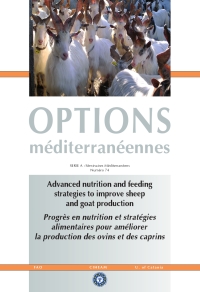| Article précédent | p. 153-157 | Article suivant |
Effects of polyethylene glycol supplementation on the performances of Cilentana goats grazing woodland and scrubland
Thirty pregnant goats grazing in woodland and scrubland were randomly allocated to two equal groups (PEG and control). They were individually given 200, 300 and 400 g of concentrate (19.2% CP and 1.0 Milk Feed Unit, equal to 1700 kcal of net energy for lactation, on DM) 45, 30 and 15 days before the delivery, respectively. 10 g/head/day of PEG mixed with a part of concentrate was offered to the PEG group. After parturition (end of January - beginning of February) the concentrate was gradually increased for both groups up to 500 g/head. After weaning of kids (60 days), individual milk yield was recorded every 30 days with analyses for protein, fat, lactose and urea. Quercus ilex and Pirus amygdaliformis were the main woody species present in the grazing areas. No differences were found between groups for kid birth weights and daily weight gain (DWG); the PEG supplement affected only milk yield registered after weaning (1210 vs 1065 g/day; P<0.01), mainly in spring.
Trente chèvres en gestation en pâturage sur des forêts et broussailles ont été distribuées au hasard en deux groupes égaux (PEG et témoin). Il leur a été distribué individuellement 200, 300 et 400 g de concentré (19,2% PB et 1,0 UFL, égal à 1700 kcal d'énergie nette pour la lactation, sur MS) à 45, 30 et 15 jours avant la parturition, respectivement. 10 g/tête/jour de PEG mélangés à une partie du concentré furent donnés au groupe PEG. Après la parturition (fin janvier - début février) le concentré fut graduellement augmenté chez les deux groupes jusqu'à 500 g/tête. Après le sevrage des chevreaux (60 jours), la production individuelle de lait fut enregistrée tous les 30 jours, avec analyse de protéines, matière grasse, lactose et urée. Quercus ilex et Pirus amygdaliformis étaient les principales espèces arbustives présentes dans les zones de pâturage. Il n'a pas été relevé de différences entre les groupes pour le poids à la naissance et le GMQ des chevreaux ; le supplément en PEG a affecté uniquement la production de lait enregistrée après le sevrage (1210 vs 1065 g/jour ; P<0,01), surtout au printemps. Mots-clés : Supplémentation en PEG, chèvre Cilentana, tannins, pâturage.
- [ Afficher ]
- [ Télécharger ]
- [ Exporter la citation ]
Vous pouvez télécharger la citation au format :
- [ Imprimer ]
-
Mots-clés
CHEVRE, COMPLEMENT ALIMENTAIRE, EXPERIMENTATION, LACTOSE, LAIT, MATIERE GRASSE DU LAIT, PARTURITION, PRODUCTION LAITIERE, QUALITE, REGIME ALIMENTAIRE, UREECiter cet article
Infascelli F., Cutrignelli M.I., Bovera F., Tudisco R., Zicarelli F., Calabrò S. Effects of polyethylene glycol supplementation on the performances of Cilentana goats grazing woodland and scrubland. In : Priolo A. (ed.), Biondi L. (ed.), Ben Salem H. (ed.), Morand-Fehr P. (ed.). Advanced nutrition and feeding strategies to improve sheep and goat . Zaragoza : CIHEAM, 2007. p. 153-157. (Options Méditerranéennes : Série A. Séminaires Méditerranéens; n. 74). 11. Seminar of the FAO-CIHEAM Sub-Network on Sheep and Goat Nutrition, 2005/09/08-10, Catania (Italy). http://om.ciheam.org/om/pdf/a74/00800371.pdf



